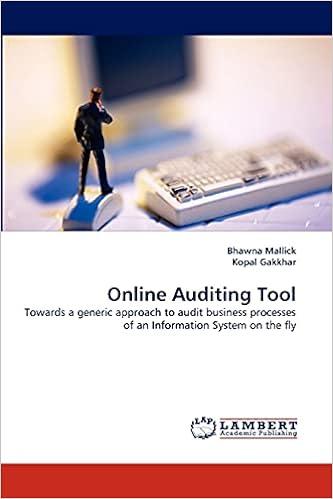Question
YOJ is a sole importer of garden tractors, which are purchased from a foreign producer and resold to local gardeners and hobby markets. The opening
YOJ is a sole importer of garden tractors, which are purchased from a foreign producer and resold to local gardeners and hobby markets. The opening balance sheet of YOJ as at 1 January 2X20 is as follows.
YOJ Balance sheet 01/01/2X20 in
Inventory 470,000 Share capital 750,000
Receivables 225,000 Retained earnings 250,000 Cash 305,000
Total assets 1,000,000 Total equity & liabilities 1,000,000
Detail information concerning the opening Balance sheet 01/01/2X20: Inventory consists of 1,000 pieces of merchandise, purchased in 2X19 for price of 470/piece Receivables consists of gross amount 250,000 owed by customers, reduced by the estimated uncollectible amounts (10% of the outstanding receivables, i.e. 25,000)
Detail information about all transactions occurring during 2X20
1. Bank loan
On 2 January 2X20, a 5-year bank loan is originated at total amount of 50,000. At the end of each year (i.e. on 31 December 2X20, 2X21, 2X22, 2X23 and 2X24), the company must repay one fifth of the loan (i.e. 10,000) plus accrued interest on the loan, equivalent to 8% of the outstanding balance as at the beginning of the year.
2. Tangible assets
The loan is used to purchase two cars. The first car costs 35,000 and is to be used by the companys chief operating manager. Its expected useful life is 3 years and then it will be sold on a secondhand market for an estimated price of 5,000. The second car, purchased for 15,000, is to be used by the sales manager. Expected useful life is 6 years and the secondhand market price at the time of disposal is estimated to be 3,000. Both cars are purchased on 5 January 2X20 and run since then.
3. Inventory and sales Information on purchases1 and sales of merchandise:
January: purchase of 750 pieces for 400/piece
February to September: sales of 1,200 piece for 840,000 in total October: purchase of 450 pieces for 460/piece
November to December: sales of 500 pieces for 400,000 in total
Information on payments from customers:
All customers with due payments at the beginning of the year have paid except for one, owing 30,000, who went bankrupt YOJ received 220,000 and remaining 30,000 had to be written-off.
At the year-end, there are outstanding receivables of 300,000 related to sales in 2X20. Based on its past experience, YOJ estimates that 10% of the closing balance of trade receivables will never be collected.
January purchase of inventory has been paid to the supplier; purchase made in October is due in February 2X21 and the payment has not been done yet.
4. Rental
In January 2X20, YOJ paid rental for the store and administrative offices. The contract is effective from January 2X20 to December 2X21 and the total amount paid for the store is 24,000 and for the offices 12,000.
5. Employees
The total salaries in 2X20 are 54,000 in the case of selling staff and 66,000 in the case of management and other administrative staff. Unpaid balance as of 31 December 2X20 is 14,000 (to be paid in January 2X21)
6. Income tax
Companys tax advisor has prepared the taxfilling (tax-return), according to which income tax expense for 2X20 is, after adjusting accounting profit for all non-deductible expenses and nontaxable income, 26,000. Liability is payable on 1 April 2X21; YOJ has made advance payments of 15,000 during 2X20.
Tasks required
Financial statements
1. Account for all transactions described above. When necessary, select an appropriate accounting policy and describe it explicitly in your solution. In case of shortage of cash, YOJ has an agreement with its bank allowing YOJ to overdraw its bank account.
2. Prepare Balance sheet statement and Income statement of YOJ as of 31 December 2X20 following generally accepted accounting principles.
3. Answer supplementary questions:
a) Do above-described transactions contain any cash-flows to be presented as cash flows from investing activities?
b) Do above-described transactions contain any cash-flows to be presented as cash flows from financing activities?
c) What is the prudence principle, and is it somehow relevant in your solution?
d) What are the main differences between equity and liabilities?
e) Are there any restrictions on distributing profits (paying out dividends) in your country?
Step by Step Solution
There are 3 Steps involved in it
Step: 1

Get Instant Access to Expert-Tailored Solutions
See step-by-step solutions with expert insights and AI powered tools for academic success
Step: 2

Step: 3

Ace Your Homework with AI
Get the answers you need in no time with our AI-driven, step-by-step assistance
Get Started


